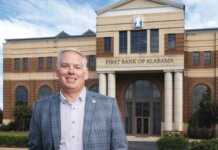
Talladega-based First Bank of Alabama is in expansion mode.
With a governor’s commendation this year for 175 years in business, First Bank lays claim to the title of Alabama’s oldest continuously operating bank.
Founded in 1848, within recent years the bank has grown from three branches in Talladega County to 12 branches and two full-service remote ATMs in a total of six East Central Alabama counties.
Additional full-service ATMs are planned, including one for Rockford, the county seat of Coosa County, which will up the bank’s service area to seven counties, says Chad Jones, president and chief executive officer of the bank.
“It’s a good way to test the waters to see if there is enough demand for a brick-and-mortar branch,” he says. “Our business plan is to grow into rural markets serving small businesses, individuals and farmers. We will offer local decision making and community lenders providing a heart of service to their communities.”
Founded by Major James Isbell in 1848, First Bank of Alabama was originally named James Isbell, Banker. Back then Talladega was a new, growing town and Isbell saw the need for a “counting room” where community members could save their money, Jones says. The well-respected bank thrived and was able to remain open during the Civil War and reconstruction periods. “The Old Bank location, a terra cotta structure completed in 1869, is just a few yards outside my office window,” Jones says.
Major Isbell’s son and son-in-law helped continue the elder Isbell’s heritage of small-town banking after Major Isbell’s death in 1871. The bank received a National Bank Charter in 1893 and its name was changed to The Isbell National Bank of Talladega. The bank continued to prosper, Jones says. “Talladega was the county seat and back in the 1900s we had a growing textile industry, wood chip mill and other industries,” he says. “Then in 1968 came the world-famous Talladega Superspeedway, which transforms our area twice a year.”
Responding to increased demand, the bank opened branches in nearby Lincoln and Munford, in 1969 and 1988, respectively. Between those branch openings, the bank’s name again was changed to First National Bank of Talladega. “We grew as the community grew,” Jones says.
But after the North American Free Trade Agreement (NAFTA) went into force in 1994, population growth slowed in the area, Jones says. “After NAFTA industries left, our young people were going off to college but not coming back to help grow the community,” he says. “We weren’t growing our deposits because our area wasn’t growing. We were dying on the vine.”
The bank’s board of directors realized after time they had to take action. They believed they had a strong banking culture that could not only continue benefitting their current customers but also new customers in other small town communities in the region, Jones says. “We knew we needed to expand outside the county line to bring our culture to new areas,” he says. “We decided we wanted to serve other rural communities offering local decision making and a good marriage of community service and community business. Our core synergy is putting back into our communities.”

A new state banking charter with the FDIC was established in 2015, and the bank was renamed First Bank of Alabama. A series of new branch acquisitions and openings in surrounding East Central Alabama counties soon began. The bank’s website tracks the timeline as part of the bank’s history.
First in 2017, FirstBanc of Alabama Inc., the parent company of First Bank of Alabama, acquired Swann Bancshares Inc. and its subsidiary Bank of Wedowee, including three full-service branches in Randolph County, in Wedowee, Roanoke and Woodland.
The next year the bank opened a seventh branch in Ashland in Clay County. An eighth full-service location opened in Oxford in Calhoun County in 2019.
During 2020, FirstBanc of Alabama announced it would acquire 100% of the stock of SouthFirst Bank and the banks would be merged. The acquisition was completed in 2021, expanding the bank’s presence into Chilton County with two more branches in Sylacauga and Clanton.
During 2022, the bank acquired two Southern States Bank offices — one in Heflin and one in Ranburne. Expanding into Cleburne County brought the bank’s total branches to 12. The bank’s assets now total about $1 billion, Jones says. “We are continuing to grow our footprint with our culture and values serving rural communities,” he says. “We want to grow community main streets, supporting local ballparks, providing local team sponsorships, supporting fund raisers, serving on nonprofit boards and local chambers of commerce.”
East Central Alabama, much of which is within an hour of Birmingham, is poised for growth, the bank’s board of directors believes, Jones says. “If you look at our area, there is much to recommend it,” he says. “Our coverage area is a draw for those who love the outdoors. It’s got Wedowee Lake, Lake Martin and Mount Cheaha. There’s a tourism draw and a draw for retirees. Many people who live in the area commute to Honda in Lincoln, Hyundai in Montgomery and Mercedes in Vance. Birmingham, of course, provides for a major commuter market, and some even commute from living in Birmingham to working in our coverage area.”
While bank acquisitions and consolidations have become commonplace in recent years, First Bank of Alabama believes there’s a difference when bank decision making is local rather than from a corporate office, Jones says. “We want to keep it local,” he says. “Our board of directors know where we have been, where we are, and where we are going. We believe this is not only the best bank in our area but the best bank in the state of Alabama, and we want to keep it that way.”
In addition to its local focus, the bank wants to offer technology and other convenience features that many community banks don’t. One example is their website chat feature, Jones points out. Through online chat, customers have the convenience of communicating to a bank employee who can get them the information or service they are interested in. “We want to be on the cutting edge but not the bleeding edge,” he says. “We don’t want to get too far out there with unproven technologies.”
Having grown up in Talladega, Jones is proud of the bank’s success. He left the area to attend Troy State, then worked for Troy Bank and Trust. After a stint in the Savannah area in Georgia, he came back home to Talladega in 2007 and began working for the bank. He rose through the ranks to his current position in 2015. “I saw coming home as a great opportunity,” Jones says. “It wasn’t the same town I grew up in, but some things, like hometown values, were the same. It’s been great to be back home with family and friends.”
Kathy Hagood and Art Meripol are Birmingham-area freelance contributors to Business Alabama.
This article appears in the October 2023 issue of Business Alabama.



